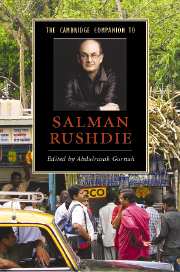Book contents
- Frontmatter
- 1 Introduction
- Part I: Themes and Issues
- Part II: Studies of Individual Texts
- 6 Tricksters and the common herd in Salman Rushdie’s Grimus
- 7 Themes and structures in Midnight’s Children
- 8 Reading ‘Pakistan’ in Salman Rushdie’s Shame
- 9 The Satanic Verses: ‘To be born again, first you have to die’
- 10 The shorter fiction
- 11 The politics of the palimpsest in The Moor’s Last Sigh
- 12 The Ground Beneath Her Feet and Fury: The reinvention of location
- Guide to further reading
- Index
- Series List
7 - Themes and structures in Midnight’s Children
from Part II: - Studies of Individual Texts
Published online by Cambridge University Press: 28 November 2007
- Frontmatter
- 1 Introduction
- Part I: Themes and Issues
- Part II: Studies of Individual Texts
- 6 Tricksters and the common herd in Salman Rushdie’s Grimus
- 7 Themes and structures in Midnight’s Children
- 8 Reading ‘Pakistan’ in Salman Rushdie’s Shame
- 9 The Satanic Verses: ‘To be born again, first you have to die’
- 10 The shorter fiction
- 11 The politics of the palimpsest in The Moor’s Last Sigh
- 12 The Ground Beneath Her Feet and Fury: The reinvention of location
- Guide to further reading
- Index
- Series List
Summary
Midnight's Children is a grand book, in the ambition and the scope of its subject, and in the daring and dynamism of its method. It is also an intimate book, attentive to childhood memories of people and neighbourhoods. In both these respects, subject and method, the novel has sources which influenced and informed its construction, and these will be discussed in more detail below. One of them is the novel The Tin Drum by Günter Grass, first published in German in 1959. In 1985, Rushdie paid this tribute to Grass and to the novel:
In the summer of 1967 . . . when I was twenty years old, I bought from a bookshop in Cambridge a paperback copy of The Tin Drum . . . There are books that open doors for their readers . . . And then there are readers who dream of becoming writers . . . [For them] there are (if they are lucky) books which give them . . . permission to become the sort of writers they have it in themselves to be. This is what Grass's great novel said to me in its drumbeats: Go for broke. Always try and do too much. Dispense with safety nets. Take a deep breath before you begin talking. Aim for the stars. Keep grinning. Be bloody minded. Argue with the world.
This was four years after the publication and great triumph of his own Midnight's Children, a novel which demonstrates the daring that Rushdie claims Grass inspired in him, and which in its own right has inspired a generation of Indian writers. Midnight's Children is now a central text in the study of the postcolonial phenomenon in writing in English, and has engaged the attention of scholars and critics, as well as the general student of literature.
- Type
- Chapter
- Information
- The Cambridge Companion to Salman Rushdie , pp. 91 - 108Publisher: Cambridge University PressPrint publication year: 2007
- 2
- Cited by

